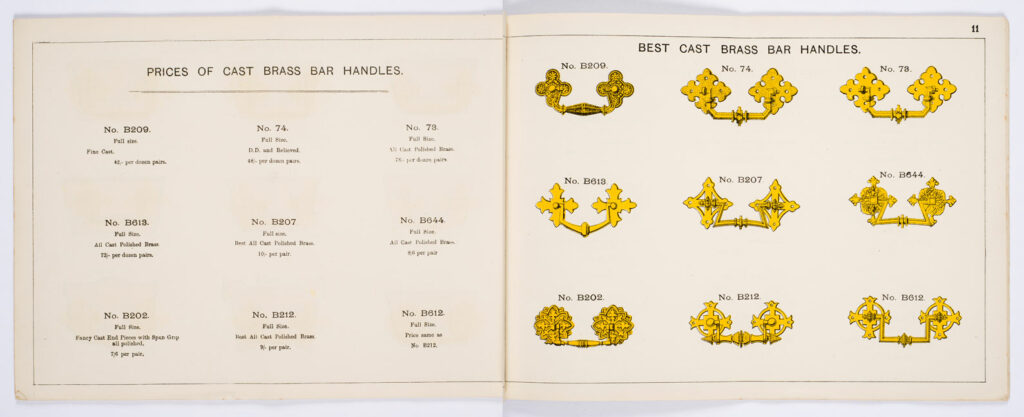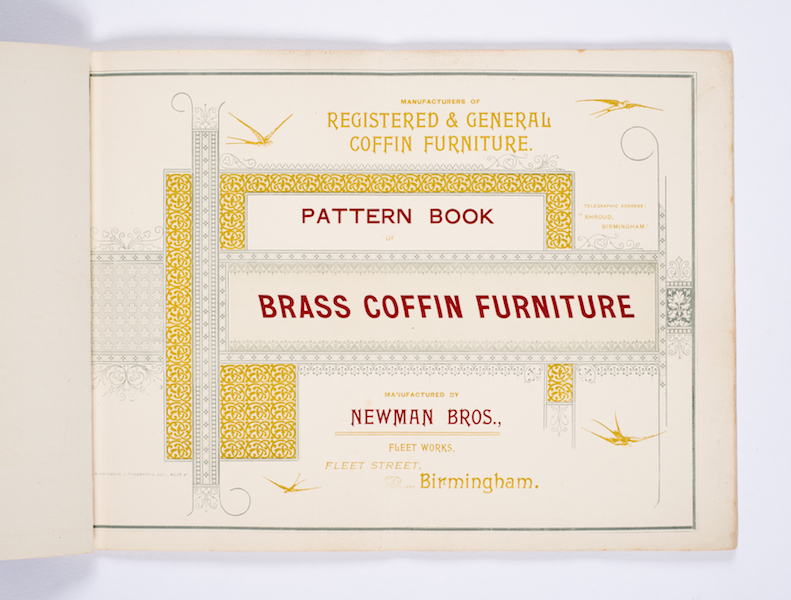

There are six different trade catalogues in the Newman Brothers’ collection, dating from the early years of the factory to the 1960s. The catalogues were aimed almost exclusively at funeral directors and they give us a good idea of what the company sold. Not everything in the catalogues was produced at the factory. There are also some Newman Brothers’ products that don’t show up in the surviving catalogues. This might be because some catalogues haven’t survived or because certain products became fashionable and then went out of fashion between the production of catalogues, we just don’t know. Some of their most exquisite Art Deco handles for instance, do not feature in their surviving catalogues, but the Registered Design numbers illustrate that they are Newman Brothers’ products.
The earliest catalogue we have may well date from 1894, when the factory opened, or a little later. The highest-quality products were made of solid brass, with cheaper “imitation brass” (plated), and nickel-plated versions available. The types of products include: cast ‘bar’ and ‘ring’ handles, stamped ornaments and back plates for handles, stamped breast plates (the plate that goes on the lid of the coffin and is engraved with the name of the deceased), coffin nails and screws, corner clips and wreath holders. Very few of the products in this catalogue remain in stock, although the dies for one or two of the designs are still on the shelves of the Stamp Room.
Click here to see Newman Brothers’ next catalogue from circa 1910.
By the 1920s, Newman Brothers had widened their range to include “coffin furniture of every description, shrouds, robes, side sheets and frillings.” A catalogue from around this time includes a range of robes, mainly in swansdown with silk and satin trimmings, and a wide range of frillings in a variety of fabrics. The range of coffin fittings had considerably widened, and the catalogue from this period includes japanned (black lacquered) breastplates like the one below, and a range of coffin lace (which despite the name is a decorative finish made of metal). The fittings were available in ‘white’, ‘white and black’, ‘black and gold enamelled’ and ‘gold’, or any ‘fancy colours’.
Click here to see pages from our 1920s’ catalogue.
There are two types of designs, ‘General’ or ‘Registered’. ‘General’ refers to common designs that stayed in fashion, and were made by all the manufacturers. ‘Registered’ designs were copyrighted, registered with the Board of Trade and exclusive to a particular manufacturer.
In 1958 Newman Brothers were taken to court by Charles Hill & Co. (CHILLCO) for infringement of a registered design. The matter was settled out of court. Newman Brothers’ director, John Kellett maintained that they had taken inspiration from an Australian design very similar to the CHILLCO one they had been accused of copying.
The next surviving catalogue we have dates from the 1960s. By then Newman Brothers had significantly reduced their product range so that it contained just over 60 products, compared with over 200 before the First World War. The most significant change is the introduction of plastic furniture.
Newman Brothers’ range of cast furniture had also dramatically reduced, featuring on just one page of the 1960s catalogue. The casting shops had been demolished by this point and by 1957 they had outsourced casting work to GEO. Gale (Die Casters) LTD.
Die casting was economical as unlike sand casting, you were able to retain the metal tool afterwards for reuse. Sand casting was also less accurate. Most of the furniture they produced was either stamped and plated in-house, or bought in from outside suppliers and finished on the premises. The failure to modernise their own equipment seems to have contributed to Newman Brothers eventual demise.
Newman Brothers do not appear to have introduced new products after the 1960s, and this is the catalogue they were still using in 1998 when they closed. It features their most popular products during their time in business, and the oldest product to feature is the cast brass Gothic handle; this features in their earliest catalogue dating from the 1890s. This is the handle that they are perhaps best known for because it is the handle that has been used on the coffins of royalty and Sir Winston Churchill.







